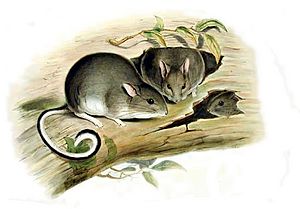White-footed rabbit-rat facts for kids
Quick facts for kids White-footed rabbit-rat |
|
|---|---|
 |
|
| Conservation status | |
| Scientific classification | |
| Genus: |
Conilurus
|
| Species: |
albipes
|
The white-footed rabbit-rat (Conilurus albipes) was a type of rodent that is now extinct. This amazing animal was once found in the woodlands stretching from Adelaide to Sydney in Australia. Over time, its home became smaller, limited to just the southeastern part of the country.
This rabbit-rat was about the size of a kitten, but it was one of Australia's largest native rodents. It was a nocturnal animal, meaning it was active at night. It loved living among the trees.
Contents
What Was the White-footed Rabbit-Rat Like?
The white-footed rabbit-rat built its nests in the hollow branches of eucalyptus trees. These nests were cozy, filled with leaves and possibly grass.
- Caring for Young: Mother rabbit-rats carried their babies attached to their teats. This meant the young ones could cling on tightly even when the mother moved. Sir George Grey, who was a governor in Australia, once wrote about finding a baby rabbit-rat still clinging to its dead mother. He said the baby held onto his glove very tightly!
Why Was It Called a Rabbit-Rat?
The native people of Sydney called this animal 'gnar-ruck'. This name means 'rabbit-biscuit', which is quite a unique name! Early settlers in Australia, around 1788, found these animals could be a problem in their food stores.
When Did It Disappear?
The last time a white-footed rabbit-rat was officially recorded was around 1845. However, some people reported seeing them later, in 1856–57, and there were even a few possible sightings in the 1930s.
Why Did They Become Extinct?
Scientists believe several things might have caused the white-footed rabbit-rat to disappear:
- New Animals: When European settlers arrived, they brought new animals like rats. These new rats might have spread diseases to the native rabbit-rats. They also might have competed with them for food.
- Predators: Cats, also brought by settlers, were likely new predators for the rabbit-rats.
- Changes to the Land: Aboriginal people used a method called firestick farming. This was a way of carefully burning parts of the land to keep the woodlands healthy. When this practice stopped, the woodlands changed, and this might have made it harder for the white-footed rabbit-rat to survive.
See also
 In Spanish: Rata conejo de pies blancos para niños
In Spanish: Rata conejo de pies blancos para niños


